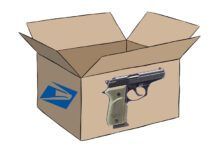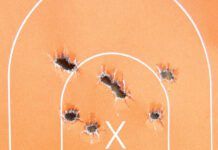(GunReports.com) — Colonel Jeff Cooper, one of the masters of self-defense handgun methods and training believed that the 1911 was the perfect combat handgun, writes CTD Suzanne on the Cheaper Than Dirt! blog.
To read the full blog post, click here
According to Cooper, there are three conditions in which you can carry your pistol. For the safest and most effective way to carry any single-action, semi-automatic pistol, Col. Jeff Cooper taught students to carry in “condition one” or “cocked and locked.” This means that your firearm is carried with a round in the chamber, the hammer is cocked, and the safety is on. To fire, all you have to do is flip the safety and pull the trigger. Some people, however, feel more comfortable with extra safety precautions such as leaving the chamber empty. This is carrying in condition three.
These three conditions, simply labeled condition one, two, and three are a part of Jeff Cooper’s Modern Technique. Cooper developed these different techniques, including his color code of awareness, to train people in practical, self-defense handgun. He was an author, instructor, WWII and Korean War veteran, sat on the board of directors for the NRA, and started the Gunsite Institute.
The three conditions I am writing about apply only to single-action, semi-automatic handguns. Glock, S&W M&P, Springfield XD, and other double/single-action handguns and revolvers operate differently. Therefore, the three conditions do not apply.
A single-action handgun is one that the hammer must be manually cocked for the gun to fire. If you look at a traditional 1911, you will see the exposed hammer at the back of the pistol, but if you look at a Glock, there is no external hammer. Examples of single-action pistols that the three carry conditions apply to are the 1911 and 1911-style handguns, CZ 75, Browning Hi-Power, SIG Sauer P238, FN five-SeveN, and full-sized Magnum Research Desert Eagle pistols.
Condition Three
Condition three means you carry your pistol without a round in the chamber, the hammer is down, and a loaded magazine is in the pistol. In order for your gun to fire, you will have to rack the slide to cock the hammer and load a round into the chamber and then take off any safety. This condition is also called “Israeli Carry.” Rumor has it that Israeli defense forces received damaged, unsafe guns with unreliable safeties. They thought carrying in any other condition was unsafe. Condition three is believed to be the best way to carry your gun to prevent an accidental discharge. However, to someone who is untrained, condition three is the slowest way to have your firearm at the ready.
Condition Two
In condition two, your gun has a round in the chamber, a full magazine inserted, the hammer down, and the safety on. Before holstering your gun, carrying in condition two requires you to load a round in the chamber. This means you must pull the slide back, cocking the hammer. Therefore, you must carefully and safely lower the hammer after you have loaded the round. To many, this is considered the safest way to carry your gun because the hammer is down—not ready to fire. However, it is also considered to be the unsafest method, because attempting to release the hammer back down with a live round in the chamber has caused numerous accidental discharges.
Condition One
Condition one is the preferred way to carry your single-action handgun. It is the way Col. Jeff Cooper taught. Everyone I know who carries a 1911 prefers to carry in condition one. Condition one means you have a round in the chamber, a full magazine inserted, the hammer is cocked, and the safety is on. This means that to fire the gun, all you must do is flip the safety.
Two other conditions have been added to the original three: condition four, which means there is no round in the chamber, no magazine inserted into the weapon, and the hammer is down. In my opinion, condition four is pointless when discussing methods of concealed carry. Condition zero means there is a round in the chamber, a full magazine inserted, the hammer is cocked, and the safety is on. Condition zero is a variation of condition one, however most do not feel the fire is the safest against an accidental discharge in condition zero.


















I know this was from 2012, but a 1911 cannot have it’s safety on when the hammer is down, as referred to in this article, as condition 2.
As written , there is no difference between condition 1 and condition zero. In condition zero, I believe you meant to say the safety is OFF.